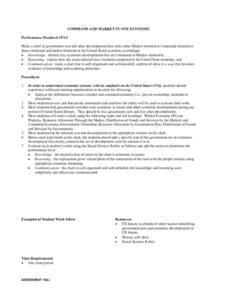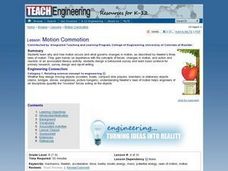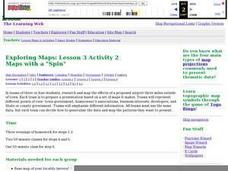Curated OER
Lessons from the Holocaust
Students discover what a dictatorship is by examining the holocaust. In this government instructional activity, students discuss the laws that were enacted for Nazis to take control of Germany, and the types of laws we have put...
Curated OER
Culture Sharing: History, Politics, Government
Students explore types of governments and political systems. In partners, students share information about their home country. Classmates work together to prepare a presentation about the history and government of a specific country.
Federal Reserve Bank
“W” Is for Wages, W-4 and W-2
Don't let your young adults get lost in the alphabet soup of their paychecks and federal income taxes. Using sample pay stubs and reproductions of government forms, your class members will identify the purpose of such forms as a W-4 and...
Curated OER
Personal Body Types
Students become familiar with four major body types; assess their own bodies, and complete an assignment showing which styles and design details would look best on different body types.
Curated OER
Command and Market in One Economy
Students organize governmental acts on a chart as either a Market or Command economy. In groups, they note the characteristics of each type of economy and identify their differences. They also explain any item that is related to the...
Curated OER
Ground Beef Experiment
Students identify what ground beef is and the difference in fat, flavor and moistness between the three types - regular, lean, and extra lean. Then, they conduct an experiment to compare the effect of pan frying
between three different...
Curated OER
I'm The Taxman!
Learners develop an understanding of how federal revenues are gained by taxes. This foundation enable students to decipher changes in federal tax policy. Groups of learners study different types of taxes and prepare presentations on each...
Curated OER
iCivics: Court Quest
Students explore the responsibilities of the Supreme Court. In this judicial branch lesson, students play an online game that requires them to respond to questions regarding the Supreme Court's responsibilities.
Howard Hughes Medical Institute
Lesson 2: Gorongosa National Park
How has Gorongosa National Park changed over time? Discover the park's rich history, dating back to primitive human times, through an interactive timeline and scientific reading. The second installment in an eight-part series explores...
Curated OER
Investigation 3 - Weathering
Fourth graders study 4 types of weather processes: wind, running water, plant growth, and freezing water. They explain how the processes of weathering and erosion change and move materials that become soil. They draw diagrams...
Curated OER
The Little Red Schoolhouse
Students read about the history of the one room school house and complete language arts activities to go with it. Students answer comprehension questions, role play, group discuss, and more.
Curated OER
The Two Sides of the Declaration of Independence
Budding historians read six documents related to grievances that led to the writing of the Declaration of Independence. They then craft an essay in which they discuss the perspective of both the colonists and the king. This DBQ could be...
Curated OER
President's Day
First graders imagine that they are the President of the United States. In this history lesson the students think of three rules or laws that they would create if they were President. The students listen to a book about George Washington...
Curated OER
My Way or the Highway
Students read "Saudis Uneasily Balance Desires for Change and Stability" from The New York Times and discuss Saudi Arabia as it considers a change from monarchy to democracy. Students work in groups to research and create timelines on...
Curated OER
Identifying Career Interests in the Volunteer and Government Sectors
Here is a great way to give your class a real-life job experience, while also serving the community. They explore a variety of volunteer opportunities to build career interests, gain work experience, and help their community grow. This...
Curated OER
Celebrity Letter Writing Assignment
High schoolers create a biographical portfolio of the three important people. They write letters of request, asking for autographs of people in assorted fields. Students are explained that an autograph could be one of the following: A...
Curated OER
Science: Motion Commotion
Students examine Newton's three laws of motion to discover what causes it and how it changes. They conduct motion experiments by building catapults and constructing balloon rockets. Finally, they conduct peer studies correlating...
Curated OER
How to Make a Rock
Second graders watch demonstrations and conduct experiments that show the three different types of rocks: igneous, sedimentary, and metamorphic.
Curated OER
That's So Square
Students familiarize themselves with the three most common geometric shapes: circles, triangles and parallelograms. They sketch, sort, and name the shapes.
Curated OER
We Choose Our Own
In this governments worksheet, students fill in a chart for how leaders rule in a monarchy, dictatorship, and republic. Students also complete 3 short answer questions.
Curated OER
Maps with a "Spin"
Students, in groups, research and map the effects of a proposed airport three miles outside of town. They prepare a presentation based on a set of maps they make and explains its different points of view from the viewpoints of the town...
Curated OER
Types of Societies
Young scholars compare and contrast the societies of India and the United States by creating a chart. In groups, they give examples of each type of classification. They present their material to the class while identifying the role of...
Curated OER
The Structure of British Columbia's Government
Eleventh graders play a "card game" centered around a "Jeopardy" type of task designed to review pertinent information on the subject of the three branches of B.C.'s government.
Curated OER
Language Arts: Two Specific Documents
Students are able to read and analyze the essential parts of two specific types of documents, the informed consent document and the position paper, used by scientists to communicate information about their research to two different kinds...

























